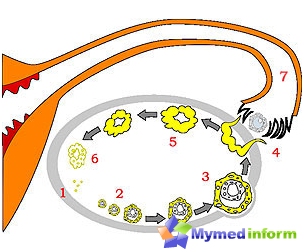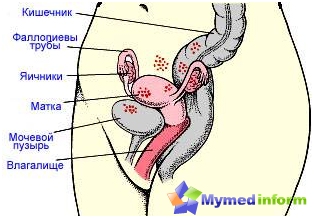Unfortunately, the diagnosis «ovarian cyst» Recently ceased to be rare. However, there are few known that under this wording is hidden not one, but a number of diseases.
Content
Cysta is the cavity filled with liquid content in the ovary. In order to understand how it arises, it is necessary to have an idea of the structure and function of ovaries. Even during the intrauterine development of the girl in its ovaries, about 2 million is laid. The smallest bubbles - follicles. Inside each of them is the embossed egg. By the time of puberty in the ovaries, the remains tsya 200-400 thousand follicles. The rest are subject to reverse development.
tsya 200-400 thousand follicles. The rest are subject to reverse development.
Under the action of hormones, the leadership work of the ovaries, one or more of the infrack (or primary) follicles begin to ripe and grow. From the group of growing eggs arbitrarily selected one, growing more actively. It will turn into a mature follicle, carrying in its wall ripened to exit the ovarian an egg and generating sex hormones - estrogens, androgens and, to a lesser extent, progesterone.
Under the influence of hormones, a gap of mature, significantly increased follicle, and the egg takes place into the abdominal cavity. This happens in the first phase of the menstrual cycle - follicular. The current of the fluid from the ripped follicle directs the egg to the rustic tube funnel. In the uterine tube under favorable conditions and fertilization occurs.
And on the site of a broken follicle, a yellow body is formed, named so because of the yellow, or lutein contained in it (Luteus Luteus «yellow») Pigment. It is produced by the same cells as the hormone progesterone, providing the second - lutein - phase of the menstrual cycle.
The progesterone of the yellow body not only contributes to fertilization, but also supports pregnancy until the placenta has fully functioned. If the fertilization did not happen, the yellow body lives in the ovary of 10-14 days, and the production of progesterone in it gradually decreases.
When it falls below a certain level, menstruation comes or, as physicians sometimes say, «The uterus cries the bloody tears on the failed pregnancy». The first day of bleeding is the beginning of the growth of the new group of eggs, the beginning of a new cycle. This happens normally, ideally.
On the picture: 1 - menstruation, 2 - ripening follicle, 3 - mature follicle, 4 - ovulation, 5 - yellow body, 6 - Yellow body stops functioning, 7 - Funnel of the fallopian tube.
Minor deviations from the norm
But in our body rarely everything happens perfectly. Moreover, when the environmental situation leaves much to be desired, and many women are uniformly and unreasonably use drugs, especially antibiotics and hormones. Therefore, young women of childbearing age increasingly breaking the function of the ovaries, cycle failures arise. For example, egg cell «Thinks» in the stage of unfinished maturation.
And the cells stopped in their development of the follicle continue to produce hormones, the follicle grows and over time turns into Follicular cyst, which can sometimes reach 6 cm in diameter. Egglet does not come out of the ovary, endometrium - the mucous membrane, lining the uterus from the inside - does not ripen, and menstruation delay is 10-15 days.
Or another option: Yellow body, instead «quiet, calm wilt» It begins to grow violently, actively produces progesterone and under its action is converted to Luteinic cyst.
Follicular and lutein cysts are formed in the process of ovary functioning (therefore doctors and call them Functional) and do not need operational treatment. After the death of the egg or a yellow body, there is absorbing such a cyst and changed monthly periods (more abundant than usual, or more scarce, or longer separating bleeding from sex tract).
Functional cysts are diagnosed mainly with the help of an ultrasound, and sometimes re-examination is required in the first, and in the second phase of the cycle. If such a patient is examined on the ultrasound after menstruation, then the cysts of the ovary will not be. If, after the monthly cyst, it will have to continue the diagnostic measures, it is best to use laparoscopy, the most gentle operational method, in which the cut of the abdominal wall is minimal, and the diagnostic capabilities are significant.
When delayed menstruation, you must make sure that there are no pregnancy using tests and ultrasound. If a woman is not pregnant, doctors in some cases drugs stimulate the occurrence of menstruation.
If due to the violation of the ovarian function instead of ordinary menstruation, bleeding is developing, it is recommended to make medical and diagnostic scraping to remove excessively grew mucous membrane.
In the ovary can also form True, not functional, cysts. There are several options for true ovarian cysts. They differ in the structure, speed of growth, a tendency to malignant (some from this point of view practically do not pose a danger, others, on the contrary, especially aggressive).
The reason for the formation of true ovarian cysts is still unknown, but one of «Studitching» 
Permanent stress, hard diet for weight loss, a large amount of genital infections, often affecting the appendages of the uterus - all these factors change the work of the ovaries. A large number of ovarian tumors are detected in women over 40 years: it is at this age that restructuring in the system regulating the ovaries occur.
Such cysts are subject to exceptionally operational treatment, since they are oncological danger. Therefore, when repeated detection of the cyst of the ovary at the ultrasound, the doctor will propose a patient more thorough diagnosis and, if necessary, operation. Optimally, if diagnosis is carried out using laparoscopy.
In some cases, the disease proceeds asymptomatic and is found randomly at the next visit to the gynecologist, in others - the formation of cysts is accompanied by obvious signs of dissatisfaction.
An example of ovarian tumors that a woman can suspect themselves, there may be hormone-active ovarian cysts. Some of them come from fabric close to the structure to male eggs, so during their development and existence, they allocate men's hormones, changing the appearance of a woman, making it like a man.
Unfortunately, these tumors are almost always malign. Among the hormonally active cyst are also those that allocate women's hormones in large quantities. As a result, girls begin premature puberty. And in women of childbearing age, the menstrual cycle changes, random bleeding arise, associated with excessive growth of the uterus mucosa, because women's hormones contribute to the development of this fabric. In the elderly women, the body seems to be rejuvenated, monthly. This option of cysts also represents a serious danger.
What you should pay attention to
The leading symptom at cysts are pain of a pulling nature at the bottom of the abdomen and in the lower back, associated with the fact that the cyst stretches the ovarian capsule, irritating the sensitive nerve endings in a small pelvic. If you are bothering pain, consult a doctor.
If there are signs of the influence of the male hormone - the strengthened hair growth on the face and the body began, acne appeared, became sick hair, you also need a consultation of a specialist. An irregular menstrual cycle should become a reason for the examination. In this case, the doctor will definitely give you a direction on the ultrasound.
Often because of a careless attitude to your health, when a woman neglects regular visits to the gynecologist, the tumor is found late. Therefore, even if you have no complaints, you need to pass the gynecologist at least once a year.
Ovarian cysts in pregnant women
When pregnancy, progesterone needs more and more, because it is necessary to maintain pregnancy before the formation of the placenta. Therefore, during pregnancy, the yellow body lives not 10-14 days, as in the menstrual cycle, but for three months. Sometimes the yellow body of pregnancy is converted into a lutein cyst, which is a sign of reinforced ovarian work.
As already mentioned, it is functional, temporary education. After the 12-weeks of the placenta assumes the production of progesterone and some other hormones, and the cyst is solved independently.
Follicular cysts during emergence does not happen, the development of follicles is interferes with a hormone prolactin (this explains the impossibility of the occurrence of a new pregnancy against the background of already existing).
Thus, if, with ultrasound of pregnancy in the first trimester, you have a ovarian cyst, then it is most likely a Lutein cyst formed due to a strong need for a pregnancy hormone - progesterone. Nevertheless, a woman will prescribe a re-examination between the first and second trimester to eliminate the true tumor.









